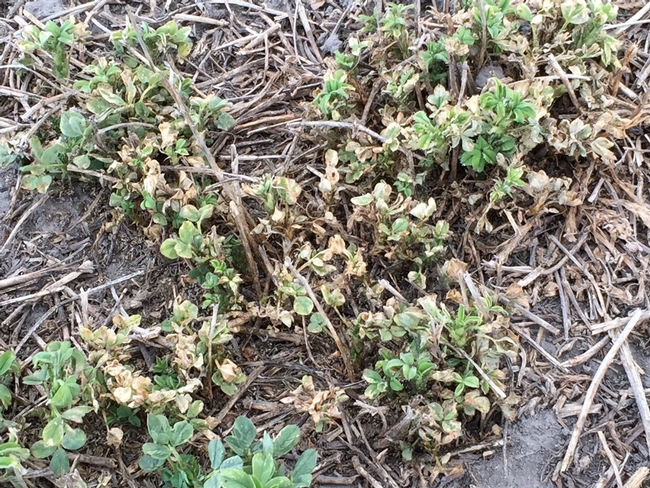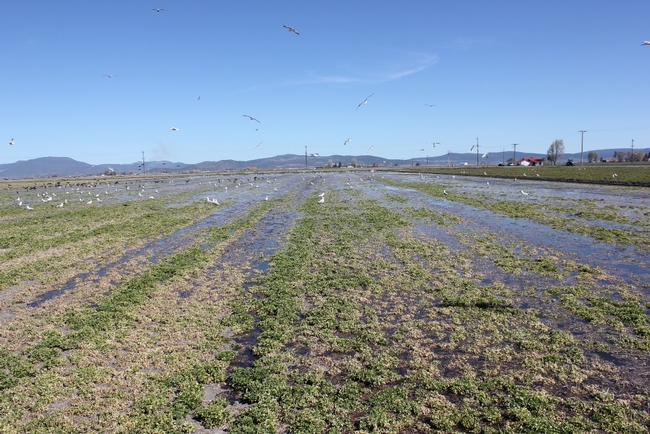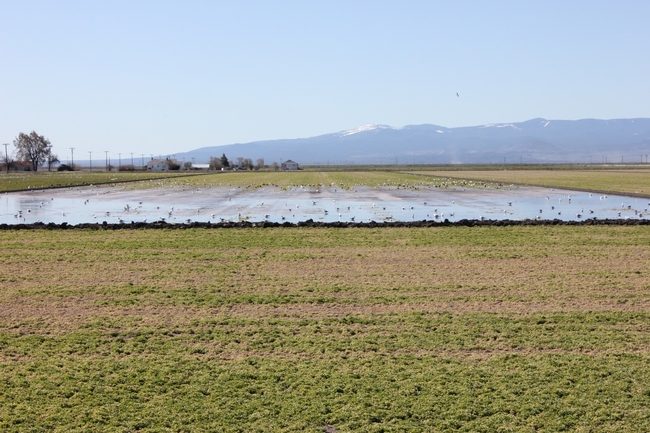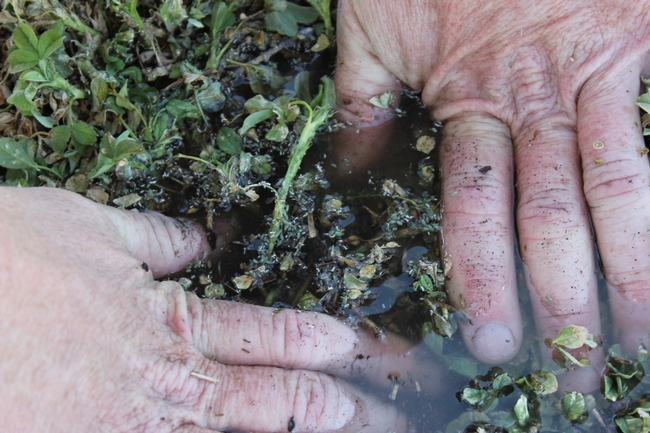As mentioned in a previous posting, the blue alfalfa aphid (BAA) situation in the Klamath Basin this year is unprecedented. To my knowledge, we have never before experienced such high aphid populations on such young alfalfa. There is a lot we don't know about this “new aphid” that invaded last year and has intensified this year. Aphids have been a periodic problem in the past in Tulelake but I believe those aphids were primarily pea aphids rather than this BAA, which injects a toxin into the plant (Figure 1). This BAA in our area and other parts of the state has been extremely difficult to control and perhaps more tolerant of high temperatures. The earliness of the problem this year is probably a reflection of the extremely mild winter weather allowing the aphids to overwinter in the fields, which enabled populations to surge early.
Regardless for the reason for this year's extremely high BAA populations, growers are left scrambling to come up with effective control measures. The combination of high BAA populations and freezing temperatures have left some fields looking scorched and they appear to be going backwards rather than actively growing. Fortunately, the insecticide Sivanto received California registration just in time for our use but regrettably supplies are extremely low due to unexpectedly high BAA populations in the Low Desert areas of Arizona and California and high populations of sugarcane aphids in sorghum in Texas creating a high demand for the product. Effective insecticide options are few and many treatments are only providing approximately 50 – 70 percent control. The concern is that with partial control, the aphid population may rapidly rebound—especially if insecticide treatments kill beneficial insects that ordinarily suppress aphid populations.
Some interesting ideas are being tossed around, and some even tried, to help reduce aphid numbers and damage. We are breaking new ground with this aphid situation and there are a lot of unknowns, but it might be good to discuss the potential effectiveness of these practices based on what has been learned about this aphid and alfalfa growth. We definitely don't have all the answers when it comes to this aphids behavior and the damage it may cause in the intermountain area. You are encouraged to post comments on your experiences (both successes and failures) if you are interested. Just Leave a comment below at the end of this article.
Harrowing: Some have noted that fields that were harrowed a month or two ago appear to have less aphid damage now. If that is the case, it was most likely due to harrowing in the dormant season disrupting aphids that were overwintering in the field or harrowing covering alfalfa with soil and making the plants less attractive to aphids that were flying in. However, harrowing the alfalfa now is likely not to have much of an effect on the high aphid population currently present in fields. In addition, harrowing is likely to damage the alfalfa.
Rolling: Rolling fields now may kill more aphids than harrowing but it is questionable how thorough a job it would do because the roller will likely raise up over the crowns protecting many aphids from the crushing action. However, smashing the new alfalfa growth will damage the plants depleting carbohydrate root reserves, as stored reserves will be used to generate new alfalfa growth.
Sheeping: Grazing alfalfa with sheep can help reduce weevil populations. Weevil eggs are laid in the stems thus grazing has a place for managing this pest. Grazing sheep will obviously consume some aphids as well. However, they do not graze close enough to the ground to provide complete control. Aphids are likely to rebound from grazing, and like crushing the alfalfa with a roller, grazing alfalfa after it has broken dormancy will deplete root reserves and reduce alfalfa vigor. I have heard a report that fields that were grazed over the winter though have significantly lower aphid populations than those that were not. This is most likely due to the hoof action disrupting aphids that were overwintering in the field and consumption of alfalfa foliage with aphids.
Burning: Flaming alfalfa fields in late winter can suppress some weeds and reduce weevil populations. It is likely it would also significantly reduce aphid populations. However, is flaming now recommended? Flaming alfalfa at this stage would kill the aphids but would require large amounts of propane and would similarly deplete alfalfa root reserves needed for vigorous new growth. Flaming may be an option in organic fields—especially to control aphids in “hot spots” (pun intended) to help reduce their spread. Most aphids currently in fields are wingless. They develop wings when populations on plants are very high or when the condition of the alfalfa host plant declines. The winged forms then take flight and move to other areas. Burning around a field to prevent the entry of aphids from adjacent fields would not be effective, as aphids migrate to new fields by flying and would simply fly over burned areas.
Flood Irrigation. Central Valley alfalfa fields are flood irrigated and it does very little there to control the aphids. However, their alfalfa varieties are classified as nondormant and there is alfalfa foliage above the level of the flood irrigation water. However, with our dormant varieties and the severely stunted alfalfa in some fields, flood irrigation water will likely overtop the alfalfa. So flooding may control some of the aphids but will also kill some of the beneficial insects that do not have wings. Some aphids may also become dislodged from the alfalfa, float and survive to re-infest the plants. So flood irrigation may help on some fields and may be worth a try especially if an irrigation is needed soon anyway. Take care not to over-irrigate, which can bring on other problems (water-logged conditions and Phytophthora root rot). Monitor soil moisture carefully and you may want to delay the next irrigation after an early flood irrigation for aphid suppression.
Some fields are being flood irrigated to reduce aphid populations. This will not eliminate the aphids but may help reduce the population depending on the height of the alfalfa and the duration of the flooding. (Photos: Skyler Peterson)
Introducing Lady Bugs. Beneficial insects are extremely important to keep aphid numbers in check. However, releasing ladybird beetles into a field is not likely to have much of an impact. Imported ladybird beetles oftentimes just leave the field where they are released and exceedingly high ladybird beetle populations would be needed to provide measurable control in the highly infested fields we are now observing.
There are no simple silver bullet solutions for controlling the aphid populations now encountered in many Klamath Basin alfalfa fields. Wise use of the most effective insecticides and trying to preserve beneficial insects are the key, but this is not easy to achieve. The cultural practices mentioned above may be partially effective but come at a price of depleting the root reserves. It is a difficult tradeoff—a partial reduction in aphid population and the toxin they inject versus a reduction in vigor from depleting root reserves. It looks like it is going to be a difficult spring and losses will be unavoidable.
There is a lot about the BAA aphid and its recent behavior that we still don't understand. Central Valley alfalfa growers experienced extensive losses the previous two years and Low Desert growers had high BAA levels the last 3 years (including this year); in all cases they had an extremely difficult time controlling the aphid. Some fields were treated as many as three to five times and in some cases growers were forced to use three-way insecticide tank mixes to get acceptable control. Why the aphids are now so difficult to manage is not known. It is not believed to be insecticide resistance because many insecticides that used to control aphids are not working well—it's not the case of just a single mode of action or insecticide that is giving poor control (which is usually the case with insecticide resistance). Many people think that it is just a “numbers game”. The aphid populations are so high that the percentage control that is usually enough with more moderate populations is not adequate for the populations we are dealing with now. Others think we could possibly be dealing with a different biotype of BAA.
Similarly, it is not completely understood why some fields are so heavily infested and neighboring fields are not. This same pattern was observed in the Central Valley. There is no simple explanation like just a difference in varietal resistance. Unfortunately, the dormant varieties we produce here do not have strong BAA resistance. BAA is typically not a problem in dormant alfalfa areas so the varieties are typically not bred for resistance. Also, it is not known why aphid populations are so high in the Klamath Basin and are not in alfalfa fields in central Siskiyou County (Butte, Shasta and Scott Valleys). It is likely due to wind patterns and aphid flights, but no one knows for sure.
We are currently evaluating different insecticides and insecticide combinations at the Intermountain Research and Extension Center. We have only done one initial evaluation so far but it appears there are some new insecticides that show promise. One is registered in another state and will hopefully have California registration next year.
It is difficult to predict what awaits alfalfa growers the rest of this season. BAA are not well adapted to high temperatures and their population typically falls when temperatures reach the mid to high 80's. This BAA does appear to be more tolerant to high temperatures though. Who knows how soon we will get sufficiently high temperatures to suppress the BAA and how much more damage to the alfalfa may occur before those temperatures are reached. Looking forward, I think BAA are likely to be a more common occurrence in the Intermountain area in the future but I think that the devastation we have observed this year is not likely to be repeated anytime soon and is probably the result of the extremely mild temperatures we had this winter. Let's hope so anyway…
Other blogs have been written on this BAA aphid problem in other areas of the state in the Alfalfa and Forage Blog. The links are below. We have learned more about the aphid since these blogs were first written. For example, the BAA is more heat tolerant than was thought.
Aphids Flourishing and Causing Problems in Southern CA Alfalfa
Blue Alfalfa Aphid Continue to be Found in High Populations in Some Locations
They're Back! Be On the Lookout for Early Aphids in Alfalfa and Share Your Observations!
The Blue Alfalfa Aphid: A continuing problem




